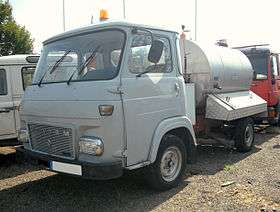Renault Super Goélette
| Renault Super Goélette | |
|---|---|
 | |
| Overview | |
| Type | Light commercial vehicle |
| Manufacturer | Saviem |
| Also called |
|
| Production | 1965–1982 |
| Assembly | Blainville-sur-Orne, France |
| Layout | |
| Powertrain | |
| Engine |
|
| Dimensions | |
| Length | 4,997 mm (196.7 in) |
| Width | 1,996 mm (78.6 in) |
| Height | 2,540 mm (100.0 in) |
| Chronology | |
| Predecessor | Renault 1 000 kg |
| Successor | Renault Master/Renault B-series |
Renault Super Goélette were vans from the small commercial vehicle range (GVW of 3.3 tonnes and 3.5 tonnes) manufactured by Saviem and marketed by Renault from 1965 to 1970, then from 1971 to 1980 by Saviem and finally by Renault Véhicules Industriels (RVI) between 1980 and 1982.
In June 1965,[1] the Renault Super Goélette SG2 replaced the Goélette with new features: wide curved windscreen, replacement of the sheet metal dashboard, steering wheel shifter, front independent, variable flexibility suspension with coil springs (rear leaf spring suspension in 1967[2]), telescopic shock absorbers and high ground clearance. However, the gasoline engine was a Étendard type.
In the fall of 1962,[2] the front end was revised: the windshield is enlarged downward, the grille is changed by abandoning its central bar and new lights were bi-colored. Inside, the dashboard was slightly changed.
In 1967, the rounded headlamps became rectangular and two new variants appeared: the first a four-wheel-drive version (later called Saviem TP3) [3] and the second a front-wheel-drive called Trafic SB2. This latest version was especially designed for urban deliveries, offering a low loading floor. The shifter was moved to the floor and the rear axle was rigid with springs.[4] The diesel version added a 3.0-litre Saviem-Alfa Romeo 599 with a MAN-licensed direct injection. Moreover, the Super Goélette SG2 was called Alfa Romeo-Saviem A15 in Italy.[5] Saviem partner MAN also marketed the SG2, naming it MAN 270.[6]
For 1969 models, the Super Goélette SG2 diesel version also incorporated MAN's direct injection. In 1971 a three-speed automatic transmission was available on the Super Goélette SG2. From 1970 the Super Goélette SG2 and SB2 Traffic were rebranded as the Saviems SG2 and SB2.[7]
In January 1974, the SG3, incorporating dual rear wheels and rear suspension with leaf springs entered production. For 1979, the external appearance was again modernised with a large black plastic grille. On 21 April 1980, following the merger of Berliet and Saviem, the small range was sold under the RVI marque.
The SG2 van was common in the 1970s before being replaced by the Master in 1980. In 1982, the remaining SG3 range was replaced by the B-series. However, the SG2 and SG3 continued in production for certain export markets. Later, SG2 and SG3 were manufactured under license in Czechoslovakia by Avia, and these were also sold with Renault badging in some countries.
References
- ↑ Jean-Gabriel Jeudy, Les camions de chez nous en couleurs, Editions E.T.A.I.
- 1 2 L'argus, 6 October 1966.
- ↑ Charge-Utile n°142, October 2004.
- ↑ L'argus, 7 December 1967.
- ↑ Wilding, A. J. P. (10 November 1967). "Lightweights in the limelight". Commercial Motor. London: Temple Press. 126 (3242): 112–113. ISSN 0010-3063.
- ↑ Wilding, A. J. P. (8 September 1967). "MAN changes through the range at Frankfurt". Commercial Motor. London: Temple Press. 126 (3234): 43. ISSN 0010-3063.
- ↑ Jean-Yves Brouard and Michel Fontany, Les véhicules du service public de chez nous, Editions MDM.
Sources and further reading
- The entry incorporates text translated from the corresponding French Wikipedia entry as of 4 March 2015.